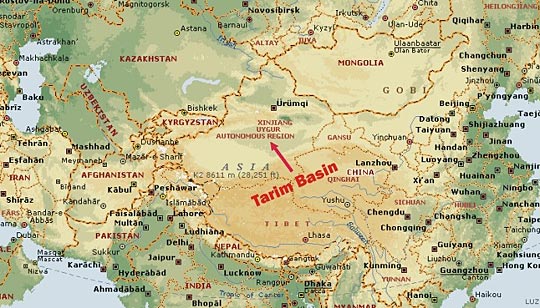
Quoting from Wikipedia:
The Tarim mummies are a series of mummies discovered in the Tarim Basin in present-day Xinjiang, China, which date from 1800 BCE to the first centuries BCE.
At the beginning of the 20th century, European explorers such as Sven Hedin, Albert von Le Coq and Sir Aurel Stein all recounted their discoveries of desiccated bodies in their search for antiquities in Central Asia. Since then, numerous other mummies have been found and analyzed, many of them now displayed in the museums of Xinjiang. Most of these mummies were found on the eastern end of the Tarim Basin, or along the southern edge of the Tarim Basin
The earliest Tarim mummies, found at Qäwrighul and dated to 1800 BCE, are of a Caucasian physical type whose closest affiliation is to the Bronze Age populations of southern Siberia, Kazakhstan, Central Asia, and the Lower Volga.
 |
| Photo courtesy Wikipedia |
My interest in these mummies is their possible relationship to the Jaredite migration across ancient Asia. The location is overlapping and the time time period, is close, although a little latter for the mummies, but they could have been from some of the remnant population left behind from Jared's group. My feeling is that Jared's people would have been a mixture of Shemites, Japhethites, and Hamites with a majority of Shemites. However, judging from the Olmec culture in the New World, the majority should have been distinctly mongoloid, but whether this cultural trait (or mutation) originated from one of the three dominant groups or some other source is not obvious. However it does seem to postdate the dispersion from Babel.
In any event, it would be wise to study the Tarim mummies, their language, writing, artifacts, etc. with a possible connection in mind.

